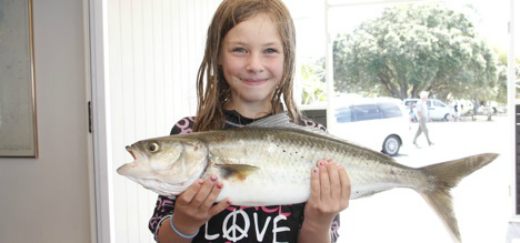According to the National Institute of Water and Atmospheric Research, the secret of New Zealand's kahawai population is all in the ear bones.
And as part of a Ministry for Primary Industries commissioned survey, NIWA staff will be asking recreational anglers in the Coromandel and Bay of Plenty for the heads of any kahawai they land this summer.
This summer NIWA staff will be interviewing recreational anglers in the Coromandel and Bay of Plenty as part of a survey on New Zealand's kahawai populations. Photo: NIWA
From January-to-April next year, NIWA staff will spend weekends interviewing anglers at 21 boat ramps between Mangonui in east Northland right down to Ohope in the Bay of Plenty.
This is the 11th consecutive summer the kahawai survey has taken place and NIWA staff hope to interview up to 5,000 fishing groups during that time.
Fisheries scientist Bruce Hartill says staff are collecting kahawai otoliths, or ear bones, which will be examined to monitor changes in the structure of the kahawai population.
'Fishing parties may be approached by an interviewer when they return to a boat ramp, and asked about their fishing trip,” says Bruce.
'We will also ask them if we can measure their catch.
'If they land any kahawai, we will ask if we can cut the heads off the fish, so that we can remove the otolith ear bones in a lab at the end of the survey.”
Otoliths are collected by scientists to determine the age of a fish. The otoliths are calcified structures that develop annual growth rings similar to tree growth rings that can be counted.
Determining the age of a fish contributes to the monitoring and management of the species. Ageing a range of fish across a population enables scientists to determine how productive that population is, and how much catch can be taken sustainably.
'Kahawai swim in small groups,” explains Bruce, 'and in schools that can be in excess of half-a-million fish.”
Recreational landings are sampled because the data they provide gives a representative snapshot of the local kahawai population, which is not available from any other source.
Information and modelling to date suggests kahawai stock has been rebuilding over the past 15 years and is now in a reasonably healthy state.
KAHAWAI – THE PEOPLE'S FISH

Tamsin Coultas with a 2.184kg kahawai caught during the 2013 Omokoroa Boat Club Fishing Competition Photo: Tracy Hardy/File
- Kahawai eat other fish, but mainly live on krill.
- The average size of a kahawai is between 40–50 cm and 1–2 kg in weight.
- Females can grow up to 60 cm in length and weigh up to 3 kg – often half a kilo heavier than males.
- The recreational catch limit for kahawai is 20 fish.
To learn more about kahawai visit the NIWA website.



0 comments
Leave a Comment
You must be logged in to make a comment.